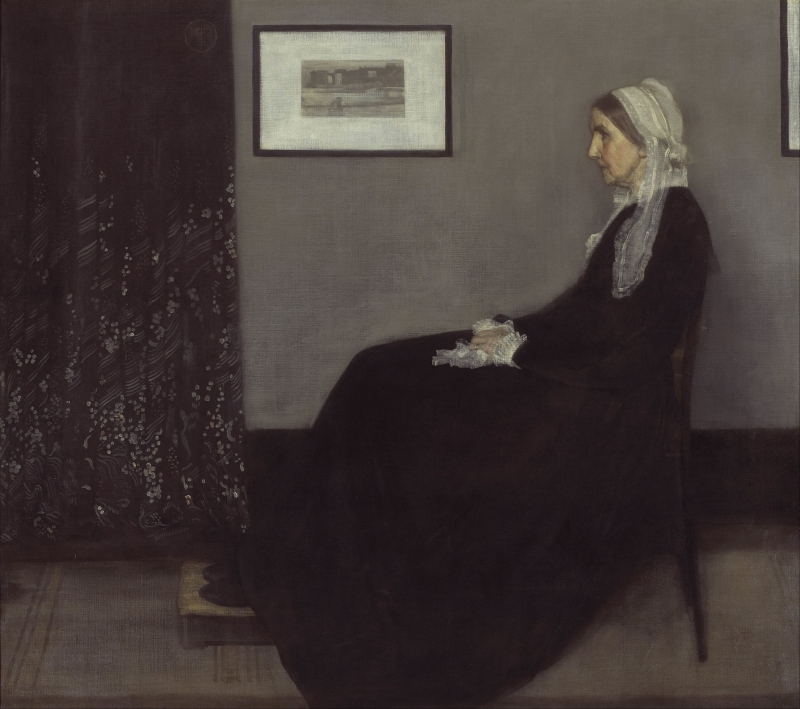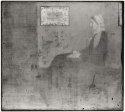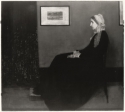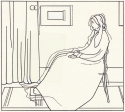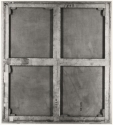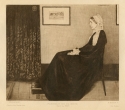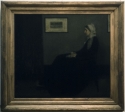Composition
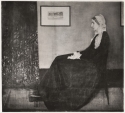
Arrangement in Grey and Black: Portrait of the Painter's Mother, photograph, 1873, New York Public Library
COMPOSITION SOURCES:
In the early 1870s Whistler made a drypoint, Whistler's Mother [103], which shows her standing; this may have been an alternative pose, rejected because the sitter could not maintain the pose for long periods.
Many writers have suggested possible sources for the composition of the oil painting. Julius Meier-Graefe (1867-1935) related it to Whistler's own At the Piano [YMSM 024]. 1
The art critic Philip Gilbert Hamerton (1834-1894) thought the source 'or the hint of it' was a Roman funerary monument like the Agrippina in the Capitol in Rome, or 'Canova's statue of Napoleon's mother at Chatsworth'. 2 Whistler was enthusiastic about various forms of neoclassical art when he was a boy (for instance, the work of Johann Heinrich Fuseli (1741-1825) and Bertel (Alberto) Thorwaldsen (ca 1770-1844)). Later Whistler was demonstrably interested in a particular form of antique sculpture, namely Tanagra statuettes.
Gibson suggested that the source for the composition was an 1861 etching of Mrs Edwin Edwards by Charles Samuel Keene (1823-1891). 3 There are obvious analogies with the work of several of Whistler's French contemporaries, including Les deux soeurs (The Two Sisters, 1859, Saint Louis Art Museum) by Whistler's close friend, Ignace-Henri-Jean-Théodore Fantin-Latour (1836-1904); La Famille Bellelli (1858-1867, Musée d'Orsay) by Hilaire-Germain-Edgar Degas (1834-1917); and – though it is less likely that Whistler knew this – Madame Manet au Piano (1868, Musée d'Orsay) by Edouard Manet (1832-1883). Furthermore Whistler admired and owned a photograph of a painting by the Belgian artist Alfred Émile-Léopold Stevens (1823-1906), La Consolation (La visite de condoléances, 1857, Musée d’Ixelles/Museum van Elsene) which showed three seated women, two in deep mourning. 4
ALTERATIONS:
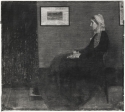
Arrangement in Grey and Black: Portrait of the Painter's Mother, photograph, raking light from below, 1973
Many alterations were made to the picture, and it appears from visual, photographic and X-ray examination that the figure and footstool were originally several centimetres higher on the canvas, that the arms and knees were tried out both in higher and lower positions, and the curtain and picture frame were originally further to the right. Infra-red photography shows a preliminary drawing, probably in ink, of several folds of drapery extending to the left below the curtain and footstool. There is a suggestion of additional work to the right of the figure, possibly a wall or a curtain, dividing the space between the figure and the edge of the canvas. The chair originally had a curved back.
The net effect of the original composition would have been that the figure appeared more enclosed in the centre of the canvas. 5
Technique
According to Thomas Robert Way (1861-1913), a cartoon of the 'Three Girls' was pricked on the canvas of Arrangement in Grey and Black: Portrait of the Painter's Mother and the figures outlined in red, and the portrait as known today was painted on the back. 6 The size of the The Three Girls (which was destroyed by the artist), as estimated from a surviving fragment and a copy of it, is not exactly the same as the portrait of Whistler's mother, but close enough for Way's account to be accepted, with reservations.
Less likely is an account by Otto Henry Bacher (1856-1909), who wrote that 'it was painted on the back of a canvas, on the face of which was the portrait of a child.' 7
Because Arrangement in Grey and Black: Portrait of the Painter's Mother [YMSM 101] has been relined it is impossible to check either Way's or Bacher's account.
The treatment of paint varies across the canvas. On the wall, the broad brushstrokes of thick cream and grey paint go in all directions. Against this surface, the face and hands have an unexpected richness of colour. The paint is rather liquid and the artist used small round brushes to apply yellow on the hands, cream and pink on the face, and white highlights.
George Moore (1852-1933) commented, 'the delicate hands of a beautiful old age lying in a small lace handkerchief are little short of miraculous. They are not drawn out in anatomical diagram, but appear and disappear, seen here on the black dress, lost there in the small white handkerchief.' 8
The pattern on the curtain was painted thinly with a round bristle brush 8 mm (1/4") wide, the grey occasionally enlivened by a thick dab of yellow paint partly mixed with white. A very subdued grey pattern was painted with small round brushes (3-4 mm) the paint as thin as watercolour. Some of the longer lines are wider, painted with a square-ended brush (6 mm wide).
A. E. Gallatin lists an undated painting by Walter Greaves (1846-1930) of Whistler painting Arrangement in Grey and Black: Portrait of the Painter's Mother, which was probably done from imagination. 9 However, Greaves did see Whistler painting Arrangement in Grey and Black: Portrait of the Painter's Mother and described Whistler's technique to the Pennells. He emphasised the sparse use of paint, 'the canvas being simply rubbed over to get the dress, and, as at first the dado had been painted all across the canvas, it even now shows through the black of the skirt'; the handkerchief Greaves said was 'nothing but a bit of white and oil.' 10 Whistler painted 'with a lot of linseed oil and little colour, and on the back of the canvas so as to imitate the grain of the dress and of the handkerchief.' 11 The white of the lace and of the handkerchief were in fact laid on rather dry, but the skirt was painted very thinly, with little variation in tone or definition of drapery. Prettejohn discusses the colour and treatment of the portrait:
"Grey and black are the quietest colours imaginable, and they are accompanied by white, another neutral hue. The canvas is barely covered by its ethereal film of pigment, and the weave of the fabric almost impreceptibly varies the texture of the fluid supervening layers, brushed as gently as 'breath on the surface of a pane of glass' … the sitter's face and hands introduce the tint – after all – of humanity, just enough warmer than the prevailing colour harmony to read as human flesh. Does this nuance simply save the colour harmony from too austere an austerity? Or does it suggest that an 'arrangement' may be something more than an abstract pattern of line and colour?'" 12
Conservation History

Arrangement in Grey and Black: Portrait of the Painter's Mother, photograph, 1873, New York Public Library
An early photograph in the Avery Collection (New York Public Library), inscribed by Whistler to Samuel Putnam Avery (1822-1904) in 1872, shows the picture before the curtain and skirt and other areas had darkened. 13
The painting was varnished in 1878 before being produced in court during the Whistler v. Ruskin trial. 14 It was probably lined before going to Paris in 1891.

Albumen print, ca 1878, signed 'Whistler', inscribed: 'To his Cousin Jacks MacNeill', GUL Whistler PH4/122

Arrangement in Grey and Black: Portrait of the Painter's Mother, half-tone photograph, n.d., GUL PH4/113

Arrangement in Grey and Black: Portrait of the Painter's Mother, Goupil Album, photograph, 1892, GUL Whistler PH5/2
Several photographs, taken over a century, document the appearance of the painting, but the various effects of lighting and exposure make it difficult to judge the condition of the painting during that time.
Sarah Walden has written two accounts of her conservation of the painting at the Musée d'Orsay, in and article, and in the biography, Whistler and His Mother (An Unexpected Relationship). 15
Frame
- 1872: the original frame was damaged by fire and either repaired or replaced: whereabouts unknown.
- 1891: Grau Whistler frame; reframed by Frederick Henry Grau (1859-1892). 16
The original frame was probably a Flat Whistler frame decorated with an incised basket-weave pattern on the frieze, similar to that seen on Symphony in Flesh Colour and Pink: Portrait of Mrs Frances Leyland [YMSM 106]. It was scorched by fire in 1872, shortly before it was sent to the Royal Academy, according to Anna Whistler:
'the 3 cases of Portraits were preserved from fire on the R R train coming from Speke Hall … the case in which my Portrait was, the flames had reached but in time discovered. the lid so burnt, a side of the frame was scorched! & yet the painting uninjured.' 17
The extent of the fire damage is unknown. Thus it is uncertain if the original frame was removed and replaced with a possible second frame (of uncertain style/pattern) or if it was simply repaired and regilt.
The painting was probably reframed by Frederick Henry Grau (1859-1892), London, in 1891. In the following year, Whistler then suggested that the old frame could be cut down, regilded, and used to frame Symphony in Grey and Green: The Ocean [YMSM 072]. 18 He also recommended that the frame for Harmony in Grey and Green: Miss Cicely Alexander [YMSM 129] should be 'Gold same soft colour as on portrait of my Mother.' 19 And in June 1892 he urged Edward Guthrie Kennedy (1849-1932) to go to Grau for frames, 'He is the only one who has the true pattern of my frame - Tell him that the gold must be the pale yellow soft gold like the gilding of my Mother's frame.' 20
Notes:
1: Meier-Graefe 1908 [more] , vol. 2, pp. 199-200.
2: Quoted in Pennell 1908 [more] , vol. 1, p. 169.
3: Gibson, Frank, ‘Whistler’s Portrait of his Mother’ in ‘Notes’, Burlington Magazine, vol. 28, 1915-1916, p. 117.
4: MacDonald 1975 [more] , at pp. 82-83. Albumen print, Special Collections, Glasgow University Library, Whistler PH3/23.
5: See MacDonald 1975 [more] ; MacDonald 2003b [more] .
7: Bacher 1909 [more] , pp. 41-42.
9: Gallatin 1913 A [more] (cat. no. 36) Walter Greaves, 'In Whistler's studio; the portrait of his mother on an easel. Dated 1869.' [sic]
10: Pennell 1908 [more] , vol. 1, p. 168.
11: Quoted in Marchant 1911 [more] .
12: Prettejohn 2007 [more] , pp. 194-98.
13: The photographer, John Robert Parsons (1925/1826-1909), was an associate of Charles Augustus Howell (1840?-1890) and also photographed works by Dante Gabriel Rossetti (1828-1882) at that time.
14: Whistler to J. E. Boehm, 20 November [1878], GUW #00322.
15: Walden, Sarah, 'Rethinking Whistler's Mother: Restoration Reveals Secrets of an American Icon', Architectural Digest, September 1991, vol. 48, pp. 42-46. Walden 2003 [more] .
16: Dr Sarah L. Parkerson Day, Report on frames, 2017. See also Parkerson 2007 [more] .
17: A. M. Whistler to J. H. Gamble, 10-20 April 1872, GUW #06549.
18: Whistler to D. C. Thomson, 21 February [1892], GUW #08212.
Last updated: 8th June 2021 by Margaret

